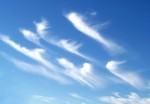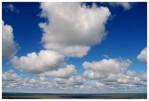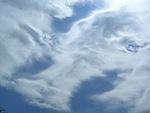When you’re out on a camping trip, odds are there is little access to internet or television – meaning you have to rely on past extended forecasts to determine the weather over the next few days. And, as anyone who has relied on a weather forecast can attest to, those extended predictions are far from reliable. In fact, they’re nearly as often wrong as they are right. Experienced campers and hikers, however, can use a few tricks to predict the weather just by paying attention to the signs Mother Nature sends.
Watch out for cloud patterns
There are a number of could patterns that can help campers and hikers to judge whether precipitation is coming. Some, though, are more reliable than others.
 Cirrus clouds – the ones that look like little wisps high up in Earth’s atmosphere – generally indicate high pressure and good weather in the near future.
Cirrus clouds – the ones that look like little wisps high up in Earth’s atmosphere – generally indicate high pressure and good weather in the near future.
 Cumulus clouds, meanwhile, hang low and usually take puffy, pillow-shaped appearances. When thick, they typically indicate the coming of a low pressure front and precipitation.
Cumulus clouds, meanwhile, hang low and usually take puffy, pillow-shaped appearances. When thick, they typically indicate the coming of a low pressure front and precipitation.
Use your nose
Plants are truly wise organisms. So wise, in fact, that they often know when precipitation is on its way before we do. They generally respond to higher moisture content in the air by increasing oxygen releases. As a result, the fresh smell of trees, bushes, and grasses will intensify before precipitation hits. So, if those flowers by your campsite are especially pungent, it might be a good day to hang out near the tent.
Pay attention to temperature and wind pattern changes
The most telltale signs of heavy precipitation are an increase in wind speed and a temperature drop. Typically, dark clouds will roll in right after these changes occur. If a day starts out calm and warm and suddenly starts to feel cooler and breezier in the early afternoon, it’s recommended that you make your way back to the campsite.
Look to the Moon
 At night, watch out for dew and rings around the moon. In the night, dew on the grass translates to higher moisture content in the air. As that air warms up the next day, the chance for cloud formation and precipitation is increased. Similarly, the type of clouds that create rings around the moon – called cirrostratus clouds – are often precursors to low pressure fronts and precipitation.
At night, watch out for dew and rings around the moon. In the night, dew on the grass translates to higher moisture content in the air. As that air warms up the next day, the chance for cloud formation and precipitation is increased. Similarly, the type of clouds that create rings around the moon – called cirrostratus clouds – are often precursors to low pressure fronts and precipitation.
With these tools in your outdoor knowledge arsenal, you won’t be in need of an unreliable weather forecast before a camping trip again. With your own senses and, of course, a little common sense, nature itself will give you all the indications you need to know what weather is headed your way.


This is awesome! Where’d you learn about these tricks? I always thought that I could sense when bad weather was coming, but these tips make it much easier to predict the weather. I can’t wait to use these in the future!